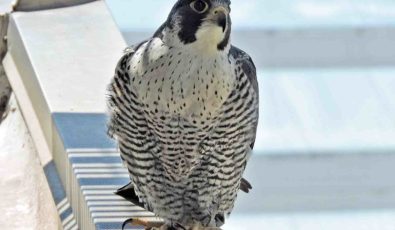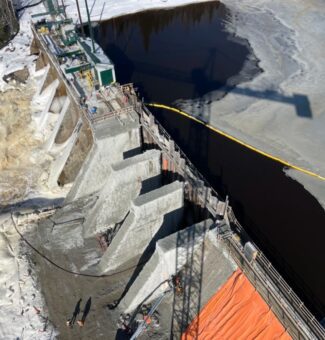Welcome home: Peregrines back at Pickering Nuclear
At the Pickering Nuclear Generating Station, two returning peregrine falcons have made the move up to some quieter real estate.
The same two parent birds have called Pickering Nuclear home since 2013, returning to the site every March to nest and raise their chicks. This year, the female falcon laid four eggs in a gravel-filled nesting box placed on a ledge close to the station’s Unit 8 building rooftop.

It’s an ideal location as it’s farthest away from Unit 5, currently undergoing a maintenance outage and typically busy with various planned tests. The birds of prey can pose a risk to workers as they
“swoop” down toward staff when they feel threatened, becoming especially territorial when their hatchlings are born around mid- May.
In order to reduce the risks, plastic streamers were installed onto the ledges of Unit 5 to visually deter the birds from nesting there. This year was the first time the peregrine falcons actually nested in an area the staff wanted them to settle.
Each year, environment staff at the plant try different methods to minimize the interaction between station workers and the birds as it’s a safety risk and stressful for the animals. Workers at the station are advised to hold brooms above their heads and walk with another person when near the falcons’ nesting area.
“The species is still in recovery, but comfortable urban nesting sites like Pickering Nuclear has allowed the species to carry on and multiply.”Mark Nash, Canadian Peregrine Foundation Director
Since 2014, seven chicks have survived and flown from the nuclear station on their own. In recent years, OPG has worked with the Canadian Peregrine Foundation (CPF) and the Ministry of Natural Resources and Forestry to tag the fledglings before they fly off around July. This identification tag, marked by a sequence of numbers, stores pertinent information like the bird’s weight, name, birth location and other important details in both a U.S. and Canadian computer database.
It’s all in an effort to keep track of the migratory bird, which has been recovering in numbers steadily since the 1960s. That decade marked the low point of the bird’s population in the province. Peregrine falcons were classified as extirpated in Ontario at the time, primarily due to the use of the pesticide DDT, but are now labelled a species of special concern.
“The species is still in recovery, but comfortable urban nesting sites like Pickering Nuclear has allowed the species to carry on and multiply,” said Mark Nash, CPF Director.
The peregrine falcon shows great site loyalty and will usually return every year if they feel comfortable and secure at a particular location, Nash said. The birds like to nest on cliff ledges or on tall buildings near large bodies of water. Sitting on the north shore of Lake Ontario, Pickering Nuclear certainly fits the bill as an ideal spot for the birds.
Subscribe and stay informed
Sign up to receive the latest news, project updates, and event information from OPG.


